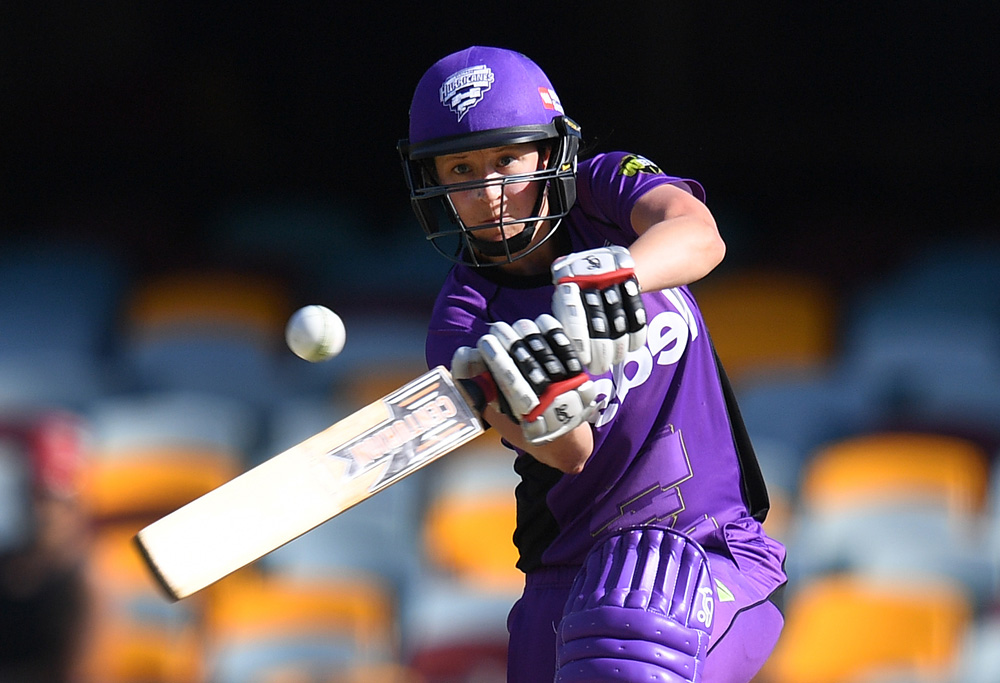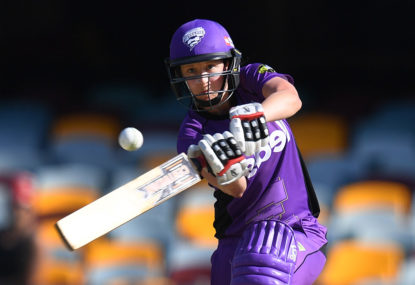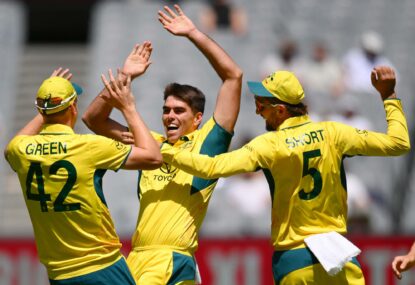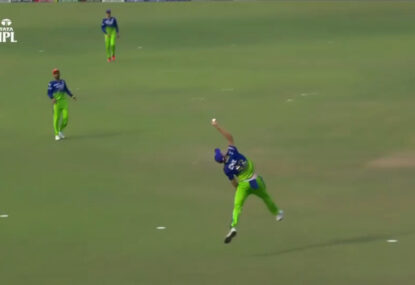Clarence had just finished warming up in preparation to bowl first in their match against University at Kangaroo Bay. Emma Thompson was putting sunscreen on when her phone started ringing, so Erin Fazackerley answered it for her.
The caller was Julia Price, coach of the Hobart Hurricanes. While Fazackerley was still out of the team – a strange time to find out that information – Thompson was back in for Hobart’s match the next day, the second match of a double-header against the Brisbane Heat.
That was last Sunday. Earlier that day Hobart had lost to the Brisbane Heat. As 12th player, Thompson had fielded during the Heat’s successful reply to Hobart’s 4/111 in place of Brooke Hepburn, who was suffering from illness.
In the past, such a change may have represented more a formal recognition of Thompson’s presence on the field than an expansion of her role in the game beyond fielding. She is not one the WBBL’s big guns. In the WBBL’s history, Thompson has essentially been a specialist fielder for the several matches that she has been considered surplus to requirements with bat and ball.
When it has been Thompson’s lot to play that role, to fill that gap in the team, she has accepted it without rancour. “You fill the gaps with people who are going to save you ten to fifteen runs in the field,” she said.
Hobart’s last match was not one such occasion. Replacing Hepburn meant that she had a clear role in the team as a bowler.
Thompson is not overly fussy about her preparation, which can be confirmed partly from personal experience. I play at the same club as her and have even been an occasional teammate. Matches at the state level allow her to focus more on her own preparation than what being captain of Clarence does at club level, yet changing levels doesn’t change her two basic training principles: preparation for her is about ‘feel’ and ‘quality’.
So when she says Hobart’s most recent match was, “Probably the most prepared I’ve possibly ever felt for a state level game,” it is a comment that sticks out.
Identity is important to any cricketer, and the most important aspects of that identity are often what someone chooses to grant you. For all the importance placed on individuals being in charge of their own preparation at Hobart – Hobart’s female players are, for example, are given autonomy over whether they represent their club in between Hurricanes fixtures – Hobart captain Corinne Hall’s use of Thompson with the ball closely matched the role she gives herself for Clarence.

(AAP Image/Dave Hunt)
A middle-to-late overs medium-pace bowler, Thompson was not facing a fundamental change in role but a need to be on the mark from ball one and not ball three of her spell. As she puts it, “A couple of balls can mean 12 runs”.
While she was not a player in Clarence kit last Monday, she was the pick of the six bowlers used by Hall. The only bowler to take two wickets anywhere in the history of the world – sorry, the only Hobart bowler to take two wickets in that match – she and Hayley Matthews were the two cheapest bowlers for Hobart, both going for only 26 from four overs. Her fourth over, the last of the innings, saw 50 per cent of her wicket tally and runs conceded.
A familiar quandary in that innings was whether to use a fielder behind square leg for bowlers like Thompson and Veronica Pyke, as their pace does not automatically necessitate a fielder in that position.
Delissa Kimmence was able to lap the ball through the vacant fine leg off the third ball of the over, prompting an immediate change in the field, with Hall moving herself to short fine-leg.
Next ball, Kimmence tried a charging drive through the onside to a fairly similar ball and was bowled. That is a tactical question that seems unique to women’s cricket. Thompson faced a universal fate off the last of the innings, being hit for six over mid-off.
That is, of course, only a brief snapshot of her work. For her three overs before her closing efforts – the 10th, 12th and 18th – she was a bowler who relied most on her deep point fielder.
As for the 16 overs in which she was just a fielder, she was regularly moved to and from the boundary. Such was the regularity, in fact, that at one could imagine that the hand gesture for her to go to the boundary was aimed at Marty the security guard in the Ricky Ponting Stand, equipped with a rope tied around Thompson’s waist to pull her back in the absence of a travelator underneath the soil at Blundstone Arena.
Only for two overs was she stationed on the hill side of the ground. However, she says, that was unintentional and, since Blundstone Arena is home for the Hobart Hurricanes, she does not make a point of practising her fielding on one side of the ground, at least for matches at Bellerive.
“Having Bellerive as our home ground, I know it pretty well,” she said.
“For a ground we don’t know particularly well, we will generally try to do a bit of fielding around the place.”
[latest_videos_strip category=”cricket” name=”Cricket”]
David Drew as assistant coach is normally the person hitting the ball in such a drill of fielding acclimatisation. He is not, however, the person who assumes responsibility for the batting order – that is, as is the wont of teams everywhere, the prerogative of the captain.
Choosing when to stick and twist when captaining the worst-performing batting team in the WBBL and having to choose between options that bat high up the order in club cricket is challenging.
In one match, Hobart’s last match of 2017, against the Sydney Thunder in Launceston, Hall tried to take on the responsibility herself at number three. Hall’s gambit lasted only one match, but Stefanie Daffara’s promotion has taken on a more permanent status. She was batting at number eight the match before her elevation to opener and, while that was low considering that she batted as high as number four in the order, she had scored a duck and a pair of 13s in the WBBL at numbers seven and eight.
Katelyn Fryett was at number 11 in one of those matches and she batted at number four in University’s most recent match.
Having been picked as a bowler, Thompson was at number ten on Monday. Considering Hobart’s struggles, it was not beyond the realms of prediction that the required run rate would be inflated enough to be a hot air balloon beyond the reach of the BFG. Coming out to bat with 53 runs off 16 balls needed pretty much fits that bill unless you believe that you are Sophie and that the BFG will throw you high enough into the sky to slam dunk the balloon into the ground.
For Thompson, the disbelief of the probable result is only suspended when the requirement is “a six most balls.” Most professional cricketers would probably give a similar answer. It is, however, a question worth asking as the stakes for a professional are greater than what they are for an amateur and with the focus in the cricket world having shifted more to individual accountability.
As the scope for a career in cricket for women has really only come in with the WBBL, it is not so much of a problem for Thompson’s generation. While only a minority of Hobart’s squad now have jobs outside cricket – Thompson is one of them – amateur or semi-professional status forced her generation to ensure they had something else behind them.
As the women’s game mirrors the men’s game, Thompson argues, the Australian Cricketers Association’s work with male players on careers outside cricket will be replicated to similar levels of success among female players, leading to a retention of perspective.
Her answer, therefore, is both reassuring and worth remembering. Thompson and Fazackerley were the only professional players in the room when they found out about their respective fates on Sunday, and there will be more dressing rooms in cricket, counting amateur and professional dressing rooms, in which a Thompson is an outlier than in which she is the norm.
The difference is that, as much as they outnumber the players in the latter category, players in the former category are not usually placed on the same pedestal.






































































































